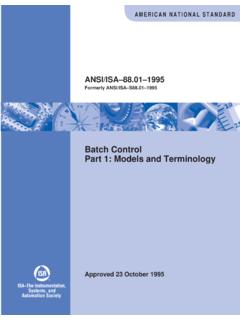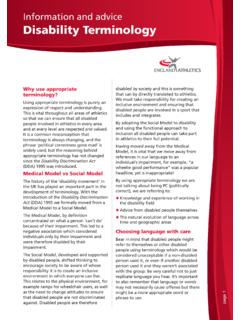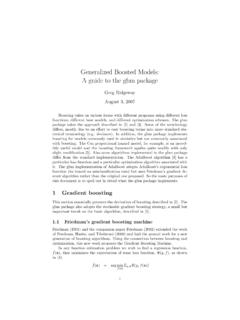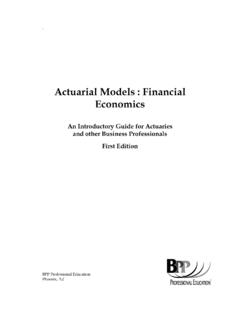Transcription of Basel Committee on Banking Supervision Consultative …
1 Basel Committee on Banking Supervision Consultative document Sound practices for backtesting counterparty credit risk models Issued for comment by 31 May 2010 April 2010 The final version of this document was published in December 2010. final version of this document was published in December 2010. Copies of publications are available from: Bank for International Settlements Communications CH-4002 Basel , Switzerland E-mail: Fax: +41 61 280 9100 and +41 61 280 8100 This publication is available on the BIS website ( ).
2 Bank for International Settlements 2010. All rights reserved. Brief excerpts may be reproduced or translated provided the source is cited. ISBN 92-9131-824-8 ISBN 92-9197-824-8 The final version of this document was published in December 2010. final version of this document was published in December 2010. Sound practices for backtesting counterparty credit risk models i Contents Introduction ..1 Evaluating Probabilistic Backtesting ..3 Time Horizons ..6 Aggregation of Data ..6 Frequency of Backtesting Analysis.
3 7 Backtesting Criteria ..8 Representative Portfolios ..8 Materiality of Results..9 Real Trade Backtesting vs Hypothetical Trade Time Horizons ..10 Initial Validation ..10 Non-Simulation Models ..10 Pricing Models ..11 The final version of this document was published in December 2010. final version of this document was published in December 2010. Sound practices for backtesting counterparty credit risk models Introduction 1. Firms with permission to use internal model methods to calculate counterparty credit risk (CCR) regulatory capital hereafter referred to as IMM firms are required to carry out on-going validation of their CCR exposure models.
4 The International Convergence of Capital Measurement and Capital Standards (ie Basel II) specifies that IMM firms backtest their expected positive exposure (EPE) models, where backtesting is defined as the comparison of the IMM model s output against realised values. Backtesting is only one element of the validation process and recent experience with IMM firms has shown it to be an area where additional instruction is needed. Backtesting of IMM models is an evolving process and a definitive methodology, as exists for market risk, has yet to be determined.
5 It is not the intention of this paper to prescribe specific methodologies or statistical tests, nor to constrain firms ability to develop their own validation techniques. Instead, this paper identifies issues with the current text of Basel II based on observed industry practice and proposes alternate text for backtesting. 2. An EPE model is designed to produce a distribution of possible exposure values at future time horizons for a particular counterparty. This distribution of exposures is currently used to determine the regulatory capital through application of the regulatory capital metric effective expected positive exposure (EEPE).
6 The IMM model itself can consist of a number of component models. Risk Factor models are used to generate paths of possible future market risk factors. Pricing models are used to translate those risk factors on a trade by trade basis into exposure values. Netting and collateral models are then used to aggregate the trade exposures into a measure of counterparty exposure. 3. Backtesting is the comparison of forecasts to realised outcomes. This comparison is either the comparison of a distribution with a single realised value at a point in time, as for market risk factor or exposure distribution backtesting, or the comparison of a single predicted value against some realised value at a point in time, as for backtesting EPE or pricing models.
7 VaR backtesting is a particular example of the former comparison of testing forecast distributions against realised outcomes. This paper argues that the VaR approach is inappropriate for backtesting the internal models used for counterparty credit risk calculations and suggests approaches that are more suitable. 4. The validation requirements for firms CCR EPE models are set out in Basel II s Annex 4, Section E, paragraphs 42-46. This document revisits these requirements in light of backtesting practice observed in IMM firms and is set out as follows.
8 The general problem of evaluating probabilistic forecast distributions in the context of CCR backtesting is discussed in the section Evaluating Probabilistic Forecasts . The section on Backtesting then sets out the principle terminology used in IMM backtesting, discusses backtesting and presents guidance on IMM backtesting requirements. Evaluating Probabilistic Forecasts 5. An IMM model produces a distribution of exposures, with each single exposure forecast assumed to be just as likely as any other.
9 Ideally the forecast distribution of exposure would be a probability forecast, with the forecasting system (ie the IMM model ) Sound practices for backtesting counterparty credit risk models 1 The final version of this document was published in December 2010. being reliable. A reliable forecasting system is one for which events occur with an observed relative frequency that is consistent with the forecasted values. For example, for a series of forecast distributions from a reliable forecasting system, events forecast with a probability of 10% should occur 10% of the time in the sample.
10 Specifically, the chance of an event lying between the pth and the qth percentile of a distribution is expected to occur with a realised frequency consistent with (q-p)% of the time in the sample, for all p < q. For the purposes of CCR modelling, an EPE model is reliable if the relative frequency of realised MtM values that lie between the pth percentile and the qth percentile of the forecast exposure distribution is consistent with the forecast probability (q-p). Similarly, for a risk factor model the relative frequency of the observed values that lie between the pth percentile and the qth percentile of the risk factor distribution should be consistent with the forecast probability (q-p).















